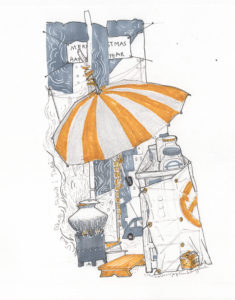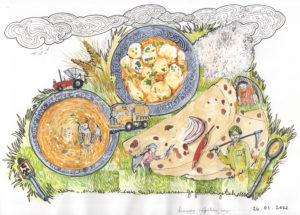Shillong-based artist, Careen Joplin Langstieh is known for her depiction of Khasi women in her works, giving us a glimpse of their day-to-day lives.
Her profile in SaatchiArt says, “My works display an introspective exploration of my journey within the realm of my tribal community. While many of my paintings may be interpreted as a soliloquy wrung out from personal experiences, my works are an intricate fabric of my worldview woven in tandem with the ecology of my time.”

She was a part of the 51st National Exhibition of Art and has participated in national workshops organised by Lalit Kala Akademi. She has had two solo exhibitions – one in Shillong organised with Martin Luther Christian University and the other at the Academy of Fine Arts, Kolkata.
Sunday Shillong caught up with Langstieh to get a glimpse of her world. Here are excerpts from the interview:
SS: Tell us something about yourself.
CJL: I grew up in Shillong and was very timid. My only refuge: some white paper and pencil. This medium transported my fears and my insecurities away. I was never into sports and I did not like school at all. I love music. Growing up, I just knew that my life would revolve around art – that of painting.
SS: You often say your works are “in tandem with the ecology of time”. Can you tell us more about that?
CJL: Ecology here relates to physical and notional domains. While the creative process can be therapeutic and liberating, it is influenced by one’s personal view and experience of things. My works are not necessarily direct statements. Rather, they are conversations between an observing mind and the working elements on the canvas.
SS: Who would you regard as your biggest influence?
CJL: My biggest influence was my late teacher Mainul Haque Bharbhuiya. I still go back to the lessons he taught me. In some way, my strong female subjects were inspired by some of his works.
SS: In the digital age, what role can multimedia play in the artistic space?
CJL: Painting is the culmination of a slow development beginning with the first lines in the caves. I occasionally dabble with mixed media, which itself can be a fascinating interplay of contrasting mediums. The digital presence, with its phenomenal hold on us, will definitely fuel the journey of art toward renewed as well as revolutionary forms of expressions.

SS: How has your identity as a Khasi woman shaped your journey?
CJL: I would rather explain myself first as another human sans embellishments of identity. However, I realise that my sense of being is influenced by principles governing habitation and habits of the land. Therefore, this journey is a constant classroom where one absorbs from learning yet ever mindful of our place as vulnerable conscious equals.
SS: Women, in particular Khasi women, are a recurring motif in your artworks. What is your understanding of the ‘matrilineal’ as a concept?
CJL: I am often reminded of this. The theme of recurrence could perhaps be my innate nature – finding closer connections and bonding with certain aspects of life around me. The system is what I grew up in. It becomes a concept when one can detach oneself and observe it from a perspective not given to affectations owing to familiar affiliations or divergent viewpoints. One can become easily impressionable to the many popular, academic or prescriptive attitudes on the subject.
SS: What are the challenges that artists from Meghalaya face? How can the state help the artists here?
CJL: Back in the 19th century Europe, artists would have their arts displayed in salons often backed by the ruler of the day or the government. Here we are in the 21st century. As an artist here, I would not like to waste my time and energy on expectations from quarters whose priorities are on parking lots and malls. A community that boasts of its rich culture usually has an art centre as an example. It is a repository of a collection of thoughts and memories. We have none, and that itself is self-explanatory.
The incentive for art to grow here are exclusively from independent initiatives like House No. 15 through workshops and exhibitions, and educational institutes like St. Anthony’s College with its grant for the pandemic project, Synod College which organised a seminar and curated exhibition on eyeing conflicts in the region and Martin Luther Christian University which has been conducting demonstrations and sessions on art appreciation.
SS: What would be your message to the people of Meghalaya who want to pursue art?
CJL: This is a field where practice alone will not make you perfect. This is something that requires soul searching, self-realization and an ability to perceive beyond what your sight tells you. All of this comes with age and experience, so patience is the key. I would like to add, however, that there is no end to learning and every passing phase is indicative of growth.



